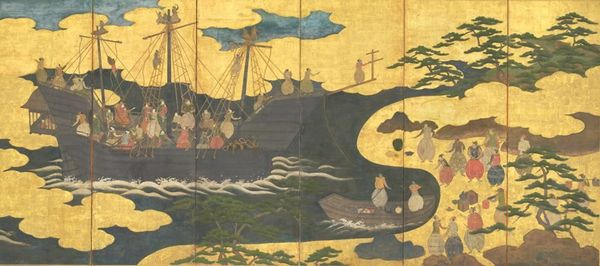Anonymous (Late 16th-Early 17th Century), A Portuguese Ship Comes to Trade
Anonymous (Late 16th-Early 17th Century), A Portuguese Ship Comes to Trade. Photo Christie's Image Ltd 2013
Six-panel screen; ink. color, gold and gold leaf on paper; 61¼ x 137½in. (155.5 x 349.5cm.). Estimate $700,000 – $900,000
Provenance: Private collection, Tokyo
Literature: Okamoto Yoshitomo and Takamizawa Tadao, Nanban byobu (Nanban screens) (Tokyo: Kashima kenkyujo shuppankai, 1970), Plate volume, color plate pp. 80-81 and fig. 58, page xiv; text volume no. 58, p. 186.
Sasaki Johei, ed., Tokubetsu kikaku byobue ten Folding screens (Kyoto: Kyoto University, 1994), pl. 1.
Sakamoto Mitsuru et al., eds., Nanban byobu shusei A Catalogue Raisonné of Nanban Screens (Tokyo: Chuokoron Bijutsu Shuppan, 2008), pl. 63.
Exhibited: University Museum, Faculty of Letters, Kyoto University, "Tokubetsu kikaku byobue ten Folding screens," 1994.6.14-7.16
Notes: Portuguese traders reached Japan in 1543, and by 1573 they had selected the Bay of Nagasaki as the ideal natural harbor for the center of their commerce. The Portuguese nau, or carrack, was known to the Japanese as the kurofune (black ship) or nanban bune, ship of the Nanban, or Southern Barbarians, so called because these foreigners arrived from the south. (The term originated in China, where all foreigners were regarded as barbarians.) The three- or four-deck carrack with its three masts was the cause of much wonder and excitement at the time of its annual visit.
The nau was designed for very long journeys. It could accommodate several hundred passengers and crew and carried enormous quantities of cargo. The lower decks held provisions stored in hundreds of barrels, sacks, jars and baskets. Provisions typically included hardtack, wine, meat, hakes, olive oil, vinegar, water, salt, sardines, chick-peas, almonds, plums, lentils, mustard, garlics, onions, sugar and honey. There would also have been live animals such as sheep, pigs and chickens. The Japanese artist here appropriately renders the elevated forecastle (bow end) and the quarterdeck with balcony below (stern end).
The carrack set off for Macao and Japan from Goa, on the west coast of India, the center of the Portuguese empire in Asia, and some of the crew are dark-skinned natives of the Indian sub-continent. Until they were expelled in 1639, the Portuguese made large profits selling Chinese silk, lacquer and ceramics to the Japanese in exchange for silver. (The sixty members of their delegation who arrived in 1640 were all beheaded.)
Dating from about 1620 to 1650, this is the left half of a pair of screens that closely follows the composition of a pair in the Nagasaki Museum of History and Culture (Nagasaki Rekishi Bunka Hakubutsukan; see Sakamoto et al., pl. 59). The right half is thought to be in a collection somewhere in the West. Like the screen in the Nagasaki Museum, this one differentiates the pale blue of the sky from the deeper sea-blue of the bay.
Religious elements are downplayed here. There are no banners with Jesuit crosses. Sails have been furled and deckhands scurry up ratlines and shrouds seeking a roost atop the crows' nests. The shrouds are fastened in deadeyes on the side of the hull. The gundeck is implied here by a few dark holes in the hull near the stern. The immense size of the ship is suggested by the rapidly diminishing size of the crew members high in the rigging. One balances precariously on the bowsprit. An officer in red, perhaps the captain, supervises the dismantling of the rigging from the comfort of his dais at the stern.
Some of the merchants have already made it to land via a small open boat of the type that accompanied them in the hold of the ship. They offload precious cargo, including lacquer and ceramics. The missing right screen would feature a Jesuit chapel and a parade of these foreigners on the main street of a Japanese port town, likely intended to represent Nagasaki (see lot 638). The artist exaggerates the height of the men and emphasizes the balloonlike bagginess of their bombacha pantaloons, but focuses also on distinct details such as heavy gold necklaces, embroidered capes and vests, assorted hats, and clothing with lively checked and striped patterns.
The earliest Nanban screens date to around 1600. The novel subject fascinated the Japanese. Professional painting ateliers in Kyoto made numerous versions for clientele prepared to enjoy the strange costumes and odd physiognomy of these taller, hairy and long-nosed Southern Barbarians, a throwback to the outlandish imagery from the iconography of Daoist immortals.
Nearly one hundred Nanban screens are now recorded, and Japanese scholars have determined that the subject ranked second in popularity only to screens depicting Scenes In and Around the Capital. What accounts for this high demand? One theory is that their foreignness and abundance of luxury goods were viewed as a charm for happiness and prosperity. Trade was auspicious and generated wealth, and the original owners of such screens were merchants in port cities. Nanban screens are the product of mainstream Kyoto painting studios, in an indigenous style typical of genre screens of the early Edo period.
Christie's. JAPANESE AND KOREAN ART. 18 September 2013. New York, Rockefeller Plaza.

/https%3A%2F%2Fprofilepics.canalblog.com%2Fprofilepics%2F1%2F0%2F100183.jpg)
/https%3A%2F%2Fstorage.canalblog.com%2F03%2F02%2F119589%2F96711876_o.jpg)
/https%3A%2F%2Fstorage.canalblog.com%2F11%2F31%2F119589%2F94773502_o.jpg)
/https%3A%2F%2Fstorage.canalblog.com%2F20%2F83%2F119589%2F94772815_o.jpg)
/https%3A%2F%2Fstorage.canalblog.com%2F26%2F72%2F119589%2F75604929_o.jpg)
/https%3A%2F%2Fstorage.canalblog.com%2F59%2F60%2F119589%2F26458628_o.jpg)



/http%3A%2F%2Fstorage.canalblog.com%2F94%2F06%2F119589%2F129141155_o.jpg)
/http%3A%2F%2Fstorage.canalblog.com%2F03%2F89%2F119589%2F128003057_o.jpg)
/http%3A%2F%2Fstorage.canalblog.com%2F19%2F50%2F119589%2F126267025_o.jpg)
/http%3A%2F%2Fscontent-cdt1-1.xx.fbcdn.net%2Fv%2Ft1.0-9%2F89867970_675673713202651_3009699329104412672_n.jpg%3F_nc_cat%3D103%26_nc_sid%3D8024bb%26_nc_eui2%3DAeGUghI_ZvCTwY70EW0arVpEqFLhTryf29bz_unR_Em9GNEgHUC4I6KWqUNQy7EQoeRV8E2ydZ1HYkD6lKNeHmN-ATpCDRYA1ZImII29DUlgNQ%26_nc_oc%3DAQn0SJpTUv7z0_UdEhXFNIFaiHtiNIQglii3EfUQQQVN6qsVcjACAjH4iliU98jsOsM%26_nc_ht%3Dscontent-cdt1-1.xx%26oh%3Da7abd987db8273f05cba055cf50d412e%26oe%3D5E9614E9)